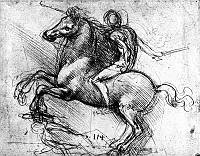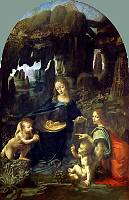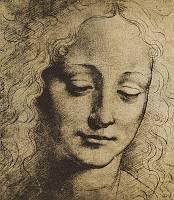Youth’s head
This is a young female head, thought to have been drawn between 1470 and 1519. It is now in the Uffizi Gallery in Florence collection of Leonardo da Vinci paintings.

Horse and Rider
Rider on a Rearing Horse Trampling a Fallen Foe. Leonardo da Vinci seemed to have been a big fan of horses, and even his rough sketches possess an almost magical lifelike quality, both in their detail and in their perspective.
Leonardo da Vinci paintings are his most famous products but he also produced some sculptures of horses not unlike this one, which may have been a preparatory sketch.

Madonna of the Rocks
One of the most popular Leonardo da Vinci paintings, this hangs in the Louvre and is thought to be the earlier of two very similar paintings. It dates from around 1483-1486. It is about 8 cm (3 in) taller than the London version. The first certain record of this picture is in 1625, when it was in the French royal collection. It is thought that this painting was privately sold by Leonardo and that the London version was painted at a later date to fulfil the commission. This painting is regarded as a perfect example of Leonardo’s “sfumato” technique. It was commissioned for the altar piece of The Chapel of the Immaculate Conception in Milan. Painted during the years 1483-86, this version of the Virgin (or Madonna) of the Rocks hangs in the Louvre in Paris. In this version the most obvious difference is that the angel’s finger is pointing, whereas in the version in the national Gallery in London, it is not. The colouring is also different.

Madonna of the Rocks
St. John the Baptist was painted by Leonardo da Vinci during 1513 to 1516. It is believed to be his last painting. This is an oil painting on walnut wood. The original size of the work was 69×57 cm. It is now exhibited at the Louvre in Paris, France.
The pointing gesture of St. John toward the heavens suggests the importance of salvation through baptism that John the Baptist represents. The inclusion of a gesture similar to John’s would increase the importance of a work with a religious conceit.
Many people are critical of this work, finding it a disturbing representation of a character normally portrayed as gaunt and fiery, living in a desert and surviving on a diet of locusts and honey. In Leonardo’s painting St. John has a womanish arm bent across his breast, his finger raised towards heaven, and that same enigmatic smile so admired on the face of Mona Lisa, a smile which can be seen in other Leonardo paintings like that of St. Anne. His face is almost faun-like and framed by a glorious cascade of curls.

Lady with Ermine
Oil on panel, 1489-1490. At the time of its painting, the medium of oil paint was relatively new. The subject is thought to be Cecilia Gallerani, the mistress of Leonardo’s employer, Ludovico Sforza.[2]At the time her portrait was painted, she was about 16 years old and was renowned for her beauty, her scholarship, and her poetry. Cecilia became the mistress of the Duke and bore him a son, but he chose to marry a different woman from a nobler family.

Sketch of a diving suit
This scuba gear, or diving suit from a Manuscript dated c1485-1487.
While working in Venice da Vinci designed his scuba gear for sneak attacks on enemy ships from underwater. The leather diving suit had a bag-like mask that went over the diver’s head. Attached to it around the nose area were two cane tubes that led up to a cork diving bell floating on the surface – an early snorkelling kit. There was also a valve-operated balloon that could be inflated or deflated, so the diver could more easily surface or sink.
To return to Leonardo da Vinci paintings, click here
To visit all painters and choose a different painter, go to Home
